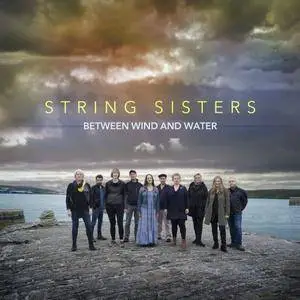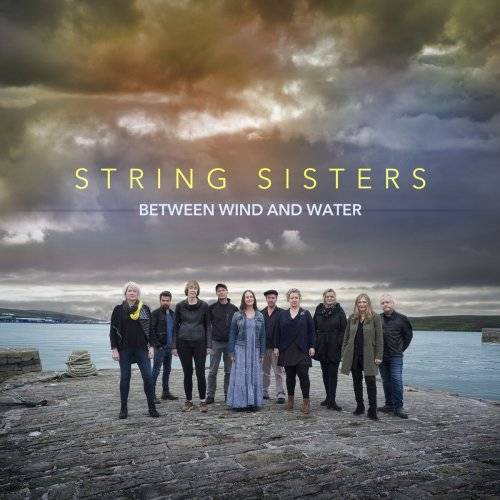String Sisters - Between Wind And Water (2018)
MP3 CBR 320kbps | 00:57:37 | 132.57 Mb | Cover
Folk | Label: String Sisters
MP3 CBR 320kbps | 00:57:37 | 132.57 Mb | Cover
Folk | Label: String Sisters
"An album that's as fascinating in its scope as it is exciting in its delivery" – Folkwords. String Sisters produces a sound that is awe-inspiring and captivating in equal measure. Capable of capturing an audience from the first few notes, their shows are a masterclass in the emotional power of instrumental music and traditional song. From heart-stopping songs performed by Emma Härdelin and Mairéad Ní Mhaonaigh to the energetic intensity of the more upbeat fiddle tunes, Between Wind and Water transfers the energy and emotion of their live performances to a studio recording.
This prestigious international project features tunes and songs written by Catriona Macdonald, Dave Milligan, Annbjørg Lien, Liz Carroll, Liz Knowles, Mairéad Ní Mhaonaigh and Tore Bruvoll. Traditional tunes and songs from Sweden, Shetland, Ireland and the United States also feature.
The album was conceived at Mareel in Shetland during ten intense and wonderfully light days in June 2017, and delivered in November 2017 at Castlesound in Edinburgh.
ABOUT THE TRACKS
THE CROW’S VISIT
As The Crow Flies (Liz Carroll)
A Visit (Annbjørg Lien)
Liz Carroll: “I originally wrote As The Crow Flies for the wonderful group Childsplay. Based in Boston, they’re a group of fiddlers who play instruments made by Bob Childs. Bob gave me the title, and this is the tune that came out.”
Annbjørg: “A Visit was inspired by those great moments when musicians visit each other and jam a tune together. These sessions have no borders and are true inspiration for musical resonance and friendships.”
WIND AND RAIN
Wind And Rain (Traditional)
Parker’s Mill (Liz Knowles)
Mairéad: “This song was given to me by the great Jody Stecher. It’s the American version of the famous Child Ballad, Twa Sisters, a universal story of love, jealousy and murder. It can be found in different traditions all over the world. Emma knows a Swedish version, but this time she sings it with me in English.”
Liz Knowles: “This tune is named for the street on which my family farm sat. In a happy, accidental String Sisters musical moment, Annbjørg thought I meant for this tune to be in 4/4 and it ended up working perfectly in this beautiful and treacherous song about a murderous sister and a fiddle!”
OPEN TO THE ELEMENTS
Walking Intro (Liz Knowles)
Gravel Walks To Grannie (Traditional Irish/Scottish)
Resistance Reel (Dave Milligan)
The Glen Road to Carrick (Traditional Irish)
Liz Knowles: “Walking was originally composed as a soundtrack for a documentary project about urban renewal, developed through an architectural and design residency in Chicago. This little round seemed to be a great intro to this reel set and very happily works as a counter-melody under the ‘A’ part of Gravel Walks To Grannie.”
Mairéad: “The Gravel Walks to Grannie is a reel named after a road outside the town of Ardara to a remote area called Grannie. This is one of the most popular reels favoured by Donegal fiddlers. The Glen Road to Carrick is a reel which celebrates the lonely road from Glencolumbkille to the neighbouring village of Carrick, in South West Donegal.”
Dave: “Resistance Reel was written for a young group from Fèis Rois in Scotland called Ceolraidh to perform at the Royal Albert Hall in London as part of the 2011 Youth Proms. It was named after a quote from US author and historian Steven Pressfield: ‘Most of us have two lives. The life we live, and the unlived life within us. Between the two stands Resistance.’”
HJALTLAND
Hjaltland To Flatland (Catriona Macdonald)
Dolkaren (traditional Norwegian)
Up Da Stroods Da Sailor Goes (Traditional Shetland)
Catriona : “I originally composed Hjaltland To Flatland for a commissioned piece entitled “Norn’ for double string quartet for the 2014 Telemark International Folk Festival. Hjaltland is old norse for Shetland and Flatland in Bø is the birthplace of many of the greatest Telemark Hardanger fiddlers. Up Da Stroods Da Sailor Goes is a maritime tune I learned from archive recordings of the wonderful Shetland fiddler George ‘Geordie’ Sutherland. Most Shetlanders knew George as a native of the island of Bressay, but he was originally from Nesting, and was closely connected to the traditional playing of that area. I remember him taking part in one of my teacher Tom Anderson’s folk festival workshops in the 1980s, when various older fiddlers were invited to demonstrate their local style. He was a great player and a real gentleman.”
Annbjørg: “Dolkaren is a traditional Hardanger Fiddle tune from Setesdal, and my variant is inspired by the great fiddler Gunnar Stubseid. Dolkaren is an old norse word; doll refers to the leather pocket you put the knife in, and has also a sexual reference to a woman’s most intimate part. The tune is therefore supposed to be played so that you can feel each beat in the music.”
DET BOR I MINA TANKAR
(Traditional Swedish)
Emma: “I learned this song from the singing of Kristina Holm. I first heard it on an old recording at the Swedish Song Archive. Kristina Holm was from Kall in the county of Jämtland close to where I grew up. The song is a classic tale of unrequited love, and betrayal, as told by the injured party.”
TROTTO
(Anon./Liz Knowles)
Liz Knowles: “This tune is an example of an afterdance, the second part of a dance pair. I found this version in a collection named, appropriately, Medieval Instrumental Dances, by Timothy J. McGee. Dance pairs would have included a first tune with a title, possibly referring to a particular choreography, and a second tune, called an afterdance, titled only “rotta”, meaning “route”, or “trotto”, a derivation from the word “trottare” meaning “to trot”. The melodies of these afterdances would have developed from the title dance, but with shorter phrases and smaller note values. This particular afterdance is missing its title dance so we know little about its origins or its choreography. For me, its charm is in the melody and the missing story behind its title tune. I love that it can be transformed so easily into a jig.”
TIGER IN THE GALLEY
Valsjö-Tigern’s Polska (Traditional Swedish)
Jarl Squad (Liz Carroll)
Emma: “I learned this traditional tune from my father and grandfather, both fiddlers from the Swedish tradition. Valsjö is a village in the county of Hälsingland, and Tigern was the fiddler (and soldier) who was famous for playing this tune. The tune was passed down fiddler to fiddler, but this way of playing it originated in the mid-nineteenth century when Tigern was active.”
Liz Carroll: “I presented this tune without a name to the String Sisters at our recording in Shetland. After Catriona arranged for us to meet the Guizer Jarl (The Jarl Squad Leader) at the Up Helly Aa galley shed in Lerwick, I decided that the tune, with its swagger, might suit the Jarl Squad and so I named it for those fabulous Vikings.”
MÓ NÍON Ó (MY DAUGHTER O)
Mó Níon Ó (Mairéad Ní Mhaonaigh)
String Arrangement by Liz Knowles
Mairéad: “This song I wrote for my daughter Nia as a lullaby and a memento of her childhood. Having her has been the biggest gift with which I was ever bestowed and it has been such an honour to raise her here on the Atlantic shores of West Donegal.”
RETURN FROM HELSINKI
(Ian Stephenson)
Catriona: “As degree programme director for Newcastle University’s BA in Folk and Traditional Music course, I have had the lucky job of working with some of the best young folk musicians from Scotland and England. Ian Stephenson, Newcastle-based guitarist and bassist, was one of the first intake in 2001. His beautiful tune Return From Helsinki marks his time as an exchange student at Sibelius Academy. I really enjoyed creating this string arrangement, taking the sisters to a sonic place where our solo voices can weave and blend, and ultimately play as one.”
VINTERFOLK
(Tore Bruvoll)
Tore: “I wrote Vinterfolk as the theme tune for a concert series at the folk music venue Riksscenen in Oslo. The concerts were presented January, hence the seasonal name for the piece.”
LATE NIGHT IN FØRDE
(Annbjørg Lien)
Annbjørg: “This is a tune that I was commissioned to write by Førdefestivalen in 2014. The work was composed for String Sisters who attended this magical festival in that year. Førdefestivalen is held in a very small village on the west coast of Norway each July, and is a miracle of ingenious hospitality. They fly in bands from all over the world who instantly form an inspirational musical community over the long weekend. And, of course, there are some wonderful sessions going on late into the night!”
THE BLOOMING CONDUCTOR (Live)
Liam Childs (Liz Carroll)
Balkin’ Balkan (Liz Carroll)
The E-B-E Reel (Liz Carroll)
Liz Carroll: “Molly Gawler is a marvellous dancer from Maine, and she created a skit/dance for the group Childsplay, and titled it, The Blooming Conductor. It was a joy to create this music which took the conductor out of her cello case to conduct a group of fiddlers. Liam Childs is named for Bob Childs’s son; Balkin’ Balkan is for a Balkan who is balking; The E-B-E Reel is woefully named for the first three notes of the tune.”
Track List:
01. The Crow's Visit 05:19
02. Wind And Rain 05:30
03. Open To The Elements 06:03
04. Hjaltland 06:37
05. Det Bor I Mina Tankar 04:22
06. Trotto 02:54
07. Tiger In The Galley 05:33
08. Mo Níon O 04:25
09. Return From Helsinki 03:48
10. Vinterfolk 02:50
11. Late Night In Forde 03:46
12. The Blooming Conductor (Live) 06:24
More Music in My Blog
Follow My RSS Channel
Follow My RSS Channel



